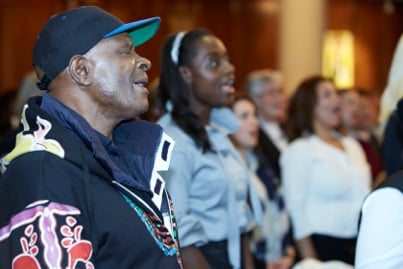
Photo: Andy Howe
Choral communities
Group singing brings many benefits to people living in areas of disadvantage, according to a new report by Evan Dawson and Kathryn Deane.
People have sung together since time immemorial to communicate or celebrate − or for no particular reason at all. In more modern times, choral societies can trace a lineage back to the West Gallery choirs of the 18th century in English parish churches. From these sprang community choirs, making group singing a widely accessible experience. During the past couple of decades, the idea of forming a choir to help individual wellbeing or to build stronger communities has become widely accepted, as seen in numerous television shows. But when we, at Making Music and at Sound Sense, sat down together a couple of years ago, we found that very little work had been done to investigate best practice in this important area. So, we decided to do some ourselves.
Funded by the Rayne Foundation and the Headley Trust, we set out to create a new approach to building community choirs in areas of disadvantage. Our objective was to answer the following question: Does a singing group in an area of disadvantage contribute to community and personal development in that area, and if so how?
I know these soft elements of wellbeing have harder impacts on health
We identified eight such communities and eight singing leaders to deliver the work in each. With the help of the Third Sector Research Centre we created an evaluation methodology that was based on leading practice in the areas of wellbeing and community research. During the course of last year, the eight leaders set to work, each taking a different approach to the task of identifying a community of disadvantage. They developed a singing group in conjunction with local community development workers, they then carried out the singing sessions and supported their group to be sustainable thereafter.
Evaluation activities included quantitative ‘distance travelled’ measures for the participants and qualitative structured interviews of the singing leaders, community development workers and participants. Here are some of the comments we received from participants and workers:
- Choir participant: “Those first few sessions were absolutely incredible. I'll never forget them. People said that they didn't know anyone on the street before, and now they've met so many.”
- Refugee participant: “We feel invisible, but you made us feel visible.”
- Local community worker: “I think I have seen confidence grow, which for me is paramount. I have seen social networks grow, friendships develop, self-esteem increased. I know these soft elements of wellbeing have harder impacts on health, just seeing people genuinely become happier in the project, they have something to look forward to every week.”
Some wonderful stories emerged, as well as some compelling qualitative data, culminating in our report ‘The Heroes Inside: Building communities in community choirs’. This was launched at the International Conference on Arts, Health and Wellbeing in Bristol during the summer. It sets out the details of what took place in each area, highlighting the particular challenges faced, the impacts on participants and their communities, and the common themes that emerged, culminating in a series of specific recommendations of best practice for the creation of community choirs in such circumstances. The evaluation identified the following:
- Singing groups can have a large impact on the wellbeing of participants in a relatively short space of time (though sample sizes were too small to show statistical significance), as well as deliver a range of other benefits to the participating organisations and the wider community.
- It is possible to create sustainable singing groups in very challenged communities, provided that sufficient time is spent in developing relationships and support from local people, and partnerships with local organisations and community workers.
- The qualities needed by the singing leader for such groups are diverse, embracing far more than just musical skills.
- Participant numbers for singing groups in challenged communities can be quite small at the outset, but this can still have a strong impact and form the basis for a sustainable group to continue. This work can take a long time to generate momentum, and short-term project funding may not be appropriate.
- There is a powerful case for singing groups to be established in disadvantaged communities. Further research is now needed to examine different models of delivery.
The evaluation methodology developed for this work can be adopted for any similar arts and wellbeing projects, and the practical tips for developing similar community choirs have already been welcomed by several organisations working in this area. The full report can be downloaded here, and we welcome comments, particularly from anyone who might be interested in working with us to create more community choirs in disadvantaged areas.
Evan Dawson is Head of Development at Making Music and Kathryn Deane is Director of Sound Sense.
www.makingmusic.org.uk
www.soundsense.org
Join the Discussion
You must be logged in to post a comment.